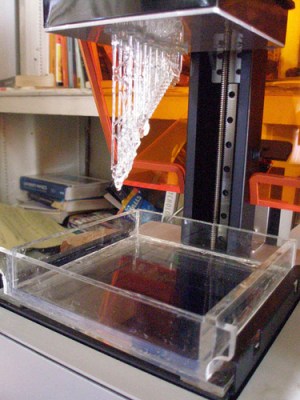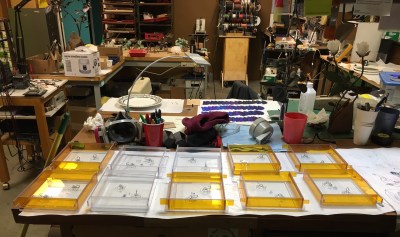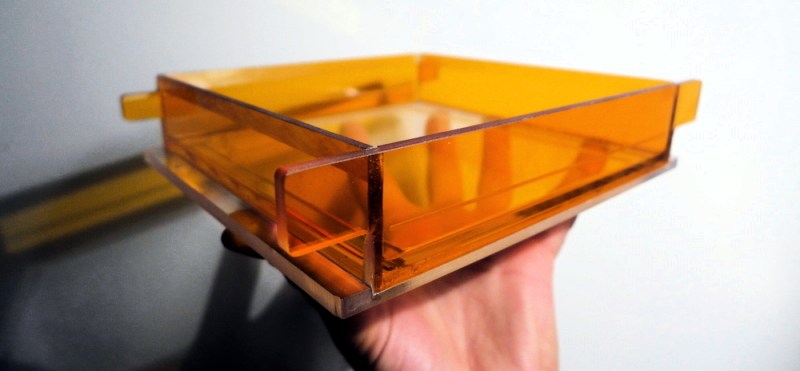Whilst designing hardware, it’s easy to shut the doors, close the blinds, and bury ourselves deeply into an after-hours design session. Although it’s tempting to fly solo, it’s likely that we’ll encounter bugs that others have handled, or perhaps we’ll realize that we forgot to add a handy feature that someone else could’ve noticed before we sent the darned PCB files out for fab. All that said, if we probe the community around us and ask for feedback, we can produce a project that’s far more functional and feature-complete in less time than if we were to design solo. Who knows? With enough eyes giving feedback on your project, maybe others will get excited enough to want one for themselves! [Andrew Werby] and [Zak Timan] on the FormLabs forums did just that: through months of iterative design and discussion on the FormLabs forums, they’ve created the first 3rd party glass resin tank that’s altogether sturdier, longer-lasting, more scratch-resistant, and less distorting than the original resin tank. And guess what? After months of trials through a few brave customers, you too can be the proud owner such a tank as they’re now up for sale on [Zak’s] website.
To Build a Resin Tank
Tired of replacing resin tanks, artist [Andrew Werby] pondered: why not build one to last? FormLabs tanks, as is, are consumables, intended only for about 1-to-2 bottles of resin before their silicone layer depletes and they join their fellow disposed brethren in the dumpster. They’re made from acrylic, which makes them brittle and easy to shatter if not removed carefully from the printer. The acrylic composition also prevents them from being cleaned with IPA, which would cause it to crack. Finally, since we can’t clean the tank and fill it with a different color, the resin-printing enthusiasts need one tank for each type of resin that they own.

After a few prints, [Andrew] noticed that the “semi-cured resin globs” that formed in acrylic tanks altogether disappeared in this glass variant. After dropping a few jaws on the forum, [Zak] made a few more tanks, sent them to a few more brave enthusiasts, and received a healthy dose of feedback both from forum followers and fresh tank users. Some insightful followers suggested alternative materials. Others wanted to store the tank outside without curing the resin. As feedback fed through the forum, the [Zak] experimented with both borosilicate glass and soda-lime glass per user suggestions. The tank walls evolved from glass to a more robust PVC and finally a sturdy UV-filtering polycarbonate. Each of these design changes stemmed from the feedback and tips of eager readers.
In the last few months, the tank has evolved into a feature-complete hybrid of UV-filtering polycarbonate that’s chemically welded to borosilicate glass coated in silicone. The bottom is embossed, enabling it to be set on a flat surface without risk of scratching. The tank can be cleaned with IPA and re-coated with silicone. The optical properties of the glass are slightly less distorting than the original’s acrylic. Finally, [Zak] and [Andrew] even received the “ok” from FormLabs to start selling the Z-Vat Glass Tank, although FormLabs is, of course, completely unaffiliated.
The Man Behind the Respirator
[Zak] is no stranger to glass. Back in high school, he fell in love with the process while watching a friend blow glass, and the two setup a shop in [Zak’s] garage. 15 years later, he’s now in the Bay Area, cracking away at floating sculptures in his current shop. The glass tank may have been dreamed up by many minds on the FormLabs forums, but making it real took someone who could play with both those ideas on the forums and the tools of the glass shop. The glass tank may look simple, but it’s an exercise in chemical welding and an ordeal in keeping a dirty glass shop dust-free for silicone coating the optical surface. With the development of glass tanks, [Zak] has forged the dreams of a few tinkerers who were looking for a tank with a bit more “oomph.”
Extra Eyes in the Build Process

[Zak] and [Andrew] didn’t finish their build alone in the dark. When [Andrew] began sharing his experience, the forum community leaped on the project and chimed in with helpful tips and relevant woes from what they saw. White papers where shared, “if-only” features were gushed, and in the end the tank evolved from a pricey all-borosilicate-build to a hybrid of materials that not only fits snugly into the printer slot, but also outlasts the lifetime of the original.

To anyone who picks up a tank like this one, you have the collective pioneers on the FormLabs forum to thank for a feature-complete tank that “just works.” And, of course, don’t forget, with a little input, you too can mold a future project into a thing that “just works” too.















Are there any open source solutions for “super”/”flex” vat solutions? Something similar to what FSL3D and Muve3D enabled.
There is Peachy Printer – I don’t know if you mean ‘solution’ as in ‘resin’ or as in ‘way of solving a problem’, but Peachy is planning on open-sourcing the compositions of the resins they have devised.
SeeMeCNC has come out with an injection molded FEP flexvat: http://www.seemecnc.com/products/universal-flexible-resin-vat-reservoir-for-diy-resin-printers
I’ve been using it for a month or so and it works well.
Why not make the bath out of anodized aluminum?
Because (a) it is exposed from below. You at least need a clear bottom to the vat in order for it to work, and (b) you can’t see how the build is progressing through aluminium.
The bottom has to be transparent for the laser beam. So you need transparent aluminum :-) Or you could make it out of crystalline aluminum oxide. But this is expensive – it is also known as sapphire.
This is pure awesome!
Joshua, a question for you. Third paragraph under To build a resin tank header, fifth sentence reads:
“As feedback fed through the forum, the bottom shifted to all-borosilicate glass, to conventional soda lime glass. ”
Should one of those “to”s be a “from”? As in:
“As feedback fed through the forum, the bottom shifted from all-borosilicate glass, to conventional soda lime glass.”
Or
“As feedback fed through the forum, the bottom shifted to all-borosilicate glass, from conventional soda lime glass.”
As it stands now the all-borosilicate glass is shifting to conventional soda lime glass, which is a neat chemical trick that [Andrew Werby] and [Zak Timan] should patent immediately for Vast Profits. :)
“TRIUMPH OF OPEN DESIGN”
What’s open about this? where are the plans for the Vat so people can have a shot at building their own?
“TRIUMPH OF OPEN DESIGN”
What’s open about this? where are the plans for the Vat so people can have a shot at building their own?